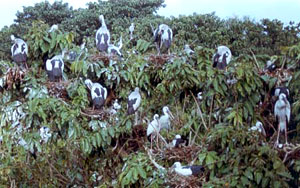The district covering an area of 3142 sq.km, was originally a part of erstwhile Bangladesh, a part of undivided India, but after the independence when India was divided, and the eastern part covering the whole area of Bengal was separated into Bangladesh (East Pakistan) and West Bengal, the western tract of Dinajpur came under the jurisdiction of Indian Government, maintained by the State Government of that particular area. However, due to some internal discord and administrative inconveniences, west Dinajpur was again subdivided into North and South Division, which form the independent separate districts.
Tourism
The district of Dinajpur in West Bengal is dissected, the major part of which falls under the present area of Bangladesh. Bounded within a small tract, the area of North Dinajpur does not have a lot of places, attracting tourists. However, mention may be made of the forests and the sanctuaries in the Districts.
 The diversified flora of deciduous variety here forms the dense, impenetrable forest, which is undoubtedly a place of immense interest for people loving forest. Sapnikla forest is the famous tourist spot, where the tourist can enjoy a beautiful lake. Several sanctuaries maintained by the state government have been grown up here. The principal one is the Raiganj bird Sanctuary, which is one of the largest sanctuary in Asia lies along the National Highway 34, which extends over an area of 35 acres. The diversified Avifauna is the key attraction here. A number of migratory birds including open billed storks, knight herons, egrets and cormorants and a large species of indigenous birds are found here.
The diversified flora of deciduous variety here forms the dense, impenetrable forest, which is undoubtedly a place of immense interest for people loving forest. Sapnikla forest is the famous tourist spot, where the tourist can enjoy a beautiful lake. Several sanctuaries maintained by the state government have been grown up here. The principal one is the Raiganj bird Sanctuary, which is one of the largest sanctuary in Asia lies along the National Highway 34, which extends over an area of 35 acres. The diversified Avifauna is the key attraction here. A number of migratory birds including open billed storks, knight herons, egrets and cormorants and a large species of indigenous birds are found here.
There are a number of temples and mosques in the region, which attracts a bunch of pilgrims in the region. Goddess Bhairabi`s Temple at Bindore and Goddess Kali`s temple at Baira are the notable ones. Burhana Fakir`s mosque famous for its architecture, which also represents the culture of the Muslims, once inhabited the land. Malgaon and Kunore are famous for the terracotta work. The small cottage industry is an important sight of interest in the region. Karnajora Museum & Park is famous for the collection of a rare kind of flora & fauna. Due to the lack of the tourist centers of ample variety, the tourism is not well developed here.
Demography
According to the demographic survey of 2001, north Dinajpur has an average population of nearly 25 lakhs and the rural areas are densely populated. Majority speaks Bengali but Hindi and Urdu is spoken by minority section in the Islampur subdivision.
Education
The district however does not provide sound base of education to the inhabitants there. As per the 2001 census, there were only 232 literates all over the district. Though there is a band of primary school, the standard of higher education is beneath the desirable rate.
However, several NGO`s have been working to set developments in the region. They maintained some schools and have developed some welfare societies to induce the social upliftment of the rural sectors.
More on West Bengal
 The diversified flora of deciduous variety here forms the dense, impenetrable forest, which is undoubtedly a place of immense interest for people loving forest. Sapnikla forest is the famous tourist spot, where the tourist can enjoy a beautiful lake. Several sanctuaries maintained by the state government have been grown up here. The principal one is the Raiganj bird Sanctuary, which is one of the largest sanctuary in Asia lies along the National Highway 34, which extends over an area of 35 acres. The diversified Avifauna is the key attraction here. A number of migratory birds including open billed storks, knight herons, egrets and cormorants and a large species of indigenous birds are found here.
The diversified flora of deciduous variety here forms the dense, impenetrable forest, which is undoubtedly a place of immense interest for people loving forest. Sapnikla forest is the famous tourist spot, where the tourist can enjoy a beautiful lake. Several sanctuaries maintained by the state government have been grown up here. The principal one is the Raiganj bird Sanctuary, which is one of the largest sanctuary in Asia lies along the National Highway 34, which extends over an area of 35 acres. The diversified Avifauna is the key attraction here. A number of migratory birds including open billed storks, knight herons, egrets and cormorants and a large species of indigenous birds are found here.



















